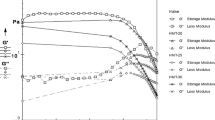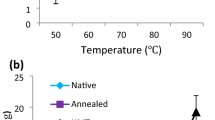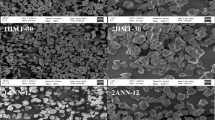Abstract
The impact of hydrothermal treatment on functional, rheological, thermal and morphological properties of pearl millet starch was investigated. Starch was modified by heat-moisture treatment (HMT) at 110 °C for 4 h at varying moisture content, i.e. 20 % (HMT-20), 25 % (HMT-25) and 30 % (HMT-30). Resistant starch (RS) content increased significantly (p < 0.05) due to HMT with maximum (6.14 %) for HMT-30. Dextrose equivalent (DE) value also increased due to HMT and ranged between 3.97 and 7.35 %. Solubility of the starch decreased, whereas swelling power and oil absorption capacity increased due to HMT. The pasting temperature increased while peak, breakdown, setback and final viscosity decreased after HMT. The G′ (storage modulus) of starch paste (5 %) from treated samples was lower as compared to native (33.5 Pa). The gelatinization temperature (Tp) increased significantly (p < 0.05) due to HMT. Pearl millet starch granules were mainly round/oval, irregular and polygonal shape with 3–12 µm size. HMT at higher moisture level (30 %) caused cavity on starch granules. This study indicated that HMT increased RS content. The gels of modified starches were softer, having higher self-levelling properties (G′–G″).


Similar content being viewed by others
Abbreviations
- AICRP:
-
All India coordinated research project
- BSR:
-
Blanket state recommendations
- FFP:
-
Farmers’ fertilizer practices
- IBSR:
-
Improved blanket state recommendation
- IGP:
-
Indo-Gangetic plain
- INS:
-
indigenous nutrient supply
- MSP:
-
Minimum support price
- NHI:
-
Nutrient harvest index
- RIE:
-
Reciprocal Internal Efficiency
- SREY:
-
System rice equivalent yield
- SSNM:
-
Site-specific nutrient management
- STLR:
-
Soil testing laboratory recommendation
- UGP:
-
Upper Gangetic Plain
References
AACC (2000) Approved methods of analysis, 10th edn. American Association of Cereal Chemists, St. Paul
AACC (2009) Approved methods of analysis, 11th edn. American Association of Cereal Chemists, St. Paul
Abdalla AA, Ahmed UM, Ahmed AR, Tinay AH, Ibrahim KA (2009) Physicochemical characterization of traditionally extracted pearl millet starch. J Appl Sci Res 5:2016–2027
Adebowale KO, Afolabi TA, Olu-Owolabi BI (2005) Hydrothermal treatments of Finger millet (Eleusine coracana) starch. Food Hydrocolloid 19:974–983
Altay FS, Gunasekaran S (2006) Influence of drying temperature, water content, and heating rate on gelatinization of corn starches. J Agri Food Chem 54:4235–4245
Beleia A, Varriano-Marston E, Hoseney RC (1980) Characterization of starch from pearl millets. Cereal Chem 54(12):1096–1107
Bhupender SK, Rajneesh B, Baljeet SY (2013) Physicochemical, functional, thermal and pasting properties of starches isolated from pearl millet cultivars. Int Food Res J 20:1555–1561
Chiu C, Solarek D (2009) Modification of starches. In: Whistler RL, Be-Miller JN (eds) Starch chemistry and technology, 3rd edn. Academic Press, Elsevier, New York, pp 629–655
Chung HJ, Liu Q, Hoover R (2009) Impact of annealing and heat-moisture treatment on rapidly digestible, slowly digestible and resistant starch levels in native and gelatinized corn, pea and lentil starches. Carbohyd Polym 75:436–447
Dundar AN, Gocmen D (2013) Effects of autoclaving temperature and storing time on resistant starch formation and its functional and physicochemical properties. Carbohyd Polym 97:764–771
Faraj A, Vasanthan T, Hoover R (2004) The effect of extrusion cooking on resistant starch formation in waxy and regular barley flours. Food Res Int 37:517–525
Freeman JE, Bocan BJ (1973) Pearl millet: a potential crop for wet milling. Cereal Sci Today 18:69–74
Hoover R, Swamidas G, Kok LS, Vasanthan T (1996) Composition and physicochemical properties of starch from pearl millet grains. Food Chem 56:355–367
Hormdok R, Noomhorm A (2007) Hydrothermal treatments of rice starch for improvement of rice noodle quality. LWT–Food. Sci Technol 40(10):1723–1731
Junistia L, Sugih AK, Manurung R, Picchioni F, Janssen L, Heeres HJ (2008) Synthesis of higher fatty acid starch esters using vinyl laurate and stearate as reactants. Starch-Starke 60:667–675
Krueger BR, Walker CE, Knutson CA, Inglett GE (1987) Differential scanning calorimetry study on the effect of annealing on gelatinization behaviour of corn starch. J Food Sci 52:715–718
Lee CJ, Kim Y, Choi SJ, Moon TW (2012) Slowly digestible starch from heat-moisture treated waxy potato starch: Preparation, structural characteristics, and glucose response in mice. Food Chem 133:1222–1229
Maache-Rezzoug Z, Zarguili I, Loisel C, Queveau D, Bule´on A (2008) Structural modifications and thermal transitions of standard maize starch after D.I.C. hydrothermal treatment, Carbohyd Polym 74(4): 802–812
O’Brien S, Wang YJ (2008) Susceptibility of annealed starches to hydrolysis by α-amylase and glucoamylase. Carbohyd Polym 72:597–607
Olayinka OO, Adebowale KO, Olu-Owolabi BI (2008) Effect of heat moisture treatment on physicochemical properties of white sorghum starch. Food Hydrocolloid 22:225–230
Osborne DR, Voogt D (1978) The analysis of nutrients in foods. Academic Press, London
Qing-Bo D, Ainsworth P, Tucker G, Marson H (2005) The effect of extrusion conditions on the physicochemical properties and sensory characteristics of rice-based expanded snacks. J Food Eng 66:283–289
Shen R, Luo S, Dong J (2011) Application of oat dextrin for fat substitute in mayonnaise. Food Chem 126:65–71
Smalligan WJ, Kelly VJ, Enad EG (1977) Preparation of a stabilized precooked baby food formulation thickened with modified tapioca starch. US patent 4,013,799, 1977
Snedecor GW, Cochran WG (1994) Statistical methods, 8th edn. Iowa State University Press, Iowa
Sun Q, Han Z, Wang L, Xiong L (2014) Physicochemical differences between sorghum starch and sorghum flour modified by heat moisture treatment. Food Chem 145:756–764
Uthumporn U, Zaidul ISM, Karim AA (2010) Hydrolysis of granular starch at sub-gelatinization temperature using a mixture of amylolytic enzymes. Food Bioprod Process 88(1):47–54
Watcharatewinkul Y, Puttanlek C, Rungsardthong V, Uttapap D (2009) Pasting properties of a heat-moisture treated Canna starch in relation to its structural characteristics. Carbohyd Polym 75:505–511
Yadav DN, Chhikara N, Anand T, Sharma M, Singh AK (2014) Rheological quality of pearl millet porridge as affected by grits size. J Food Sci Technol 51(9):2169–2175
Yadav DN, Kaur J, Anand T, Singh AK (2012) Storage stability and pasting properties of hydrothermally treated pearl millet flour. Int J Food Sci Technol 47(12):2532–2537
da Rosa Zavareze E, Dias ARG (2011) Impact of heat-moisture treatment and annealing in starches: a review. Carbohyd Polym 83:317–328
Zhang J, Chen F, Liu F, Wang ZW (2010) Study on structural changes of microwave heat-moisture treated resistant Canna starch during in vitro digestion. Food Hydrocolloid 24:27–34
Acknowledgments
The authors would like to gratefully acknowledge Director, NDRI, Karnal, India for extending Scanning Electron Microscope facilities and CCS Haryana Agriculture University, Hisar, India for providing the pearl millet variety.
Author information
Authors and Affiliations
Corresponding author
Rights and permissions
About this article
Cite this article
Sharma, M., Yadav, D.N., Singh, A.K. et al. Effect of Heat-Moisture Treatment on Resistant Starch Content as well as Heat and Shear Stability of Pearl Millet Starch. Agric Res 4, 411–419 (2015). https://doi.org/10.1007/s40003-015-0177-3
Received:
Accepted:
Published:
Issue Date:
DOI: https://doi.org/10.1007/s40003-015-0177-3




